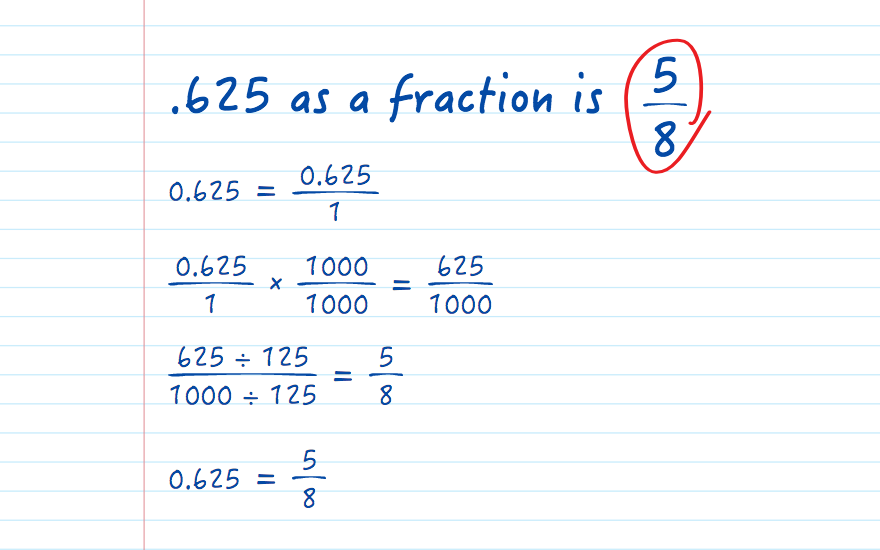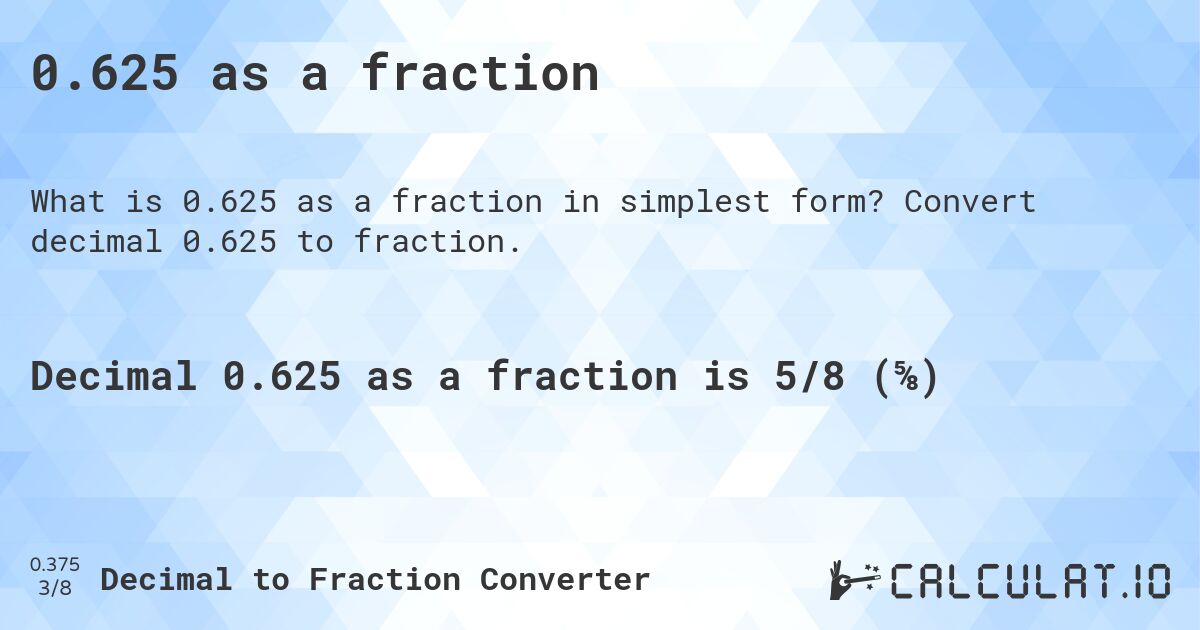What’s The Deal With .625 As A Fraction? A Deep Dive For Math Enthusiasts
If you've ever stumbled upon the number .625 and wondered what its fractional equivalent is, you're not alone. Fractions and decimals can sometimes feel like a math maze, but don’t sweat it! Today, we’re going to break it down step by step so you can understand exactly what .625 means as a fraction. Whether you're a student brushing up on your math skills or just someone curious about numbers, this guide’s got you covered. So, let’s dive in!
Understanding fractions and decimals is more than just a school lesson; it’s a real-world skill that pops up in everything from cooking to construction. Think about measuring ingredients, calculating discounts, or even splitting bills with friends. Knowing how to convert .625 to a fraction can make these tasks a whole lot easier. And trust me, it’s simpler than it seems.
Now, before we get too deep into the math, let’s set the stage. Fractions and decimals are two sides of the same coin (pun intended). They’re just different ways of expressing the same value. By the end of this article, you’ll not only know what .625 is as a fraction but also how to tackle similar conversions like a pro. Ready? Let’s go!
Read also:Unlocking The Power Of Best Iot Ssh Your Ultimate Guide
Understanding .625: The Basics
First things first, let’s talk about what .625 actually is. In the world of numbers, .625 is a decimal. But decimals and fractions are best friends, and converting one to the other is like translating between two languages. The goal here is to express .625 as a fraction, which means finding two numbers—a numerator and a denominator—that represent the same value.
Why Does .625 Matter?
Here’s the deal: .625 might seem like just another number, but it’s actually pretty useful. Imagine you’re baking a cake and the recipe calls for 5/8 of a cup of sugar. Guess what? That’s the same as .625! Understanding this conversion can save you a ton of time and frustration. Plus, it’s just cool to know how numbers work together.
Another example? Let’s say you’re shopping and something is on sale for 62.5% off. Converting that percentage to a fraction (or decimal) can help you figure out exactly how much you’re saving. Math isn’t just about equations; it’s about solving real-life problems.
Converting .625 to a Fraction: Step by Step
Alright, now for the fun part. How do we actually convert .625 to a fraction? It’s easier than you think. Here’s the step-by-step process:
- Write down .625 as a fraction over 1: .625/1.
- Multiply both the numerator and denominator by 10 for every digit after the decimal point. Since .625 has three digits, multiply by 1000: (625/1000).
- Simplify the fraction by dividing both the numerator and denominator by their greatest common divisor (GCD). In this case, the GCD of 625 and 1000 is 125, so divide both by 125: (625 ÷ 125)/(1000 ÷ 125) = 5/8.
Voila! .625 as a fraction is 5/8. Easy peasy, right?
Why Simplify Fractions?
Simplifying fractions makes them easier to work with. Think of it like organizing your closet—neater and more manageable. When you simplify 625/1000 to 5/8, you’re left with a cleaner, more straightforward fraction that’s easier to use in calculations.
Read also:Ivan Sergei Unveiling The Life And Achievements Of A Rising Star
Real-World Applications of .625 as a Fraction
Now that we’ve cracked the code on .625 as a fraction, let’s talk about where this knowledge comes in handy. Here are a few real-world scenarios where knowing this conversion can be a game-changer:
- Cooking and Baking: Recipes often use fractions for measurements. If a recipe calls for 5/8 of a cup of flour, you’ll know exactly how much to use.
- Construction and Carpentry: Builders and carpenters frequently use fractions to measure materials. Knowing that .625 equals 5/8 can help with precise cutting and fitting.
- Finance and Budgeting: Understanding percentages and fractions is crucial for managing money. If you’re calculating a 62.5% discount, converting it to 5/8 can make the math simpler.
Common Misconceptions About Decimals and Fractions
Let’s clear up some confusion. A lot of people think decimals and fractions are completely different things, but they’re actually just different representations of the same value. Here are a few common misconceptions:
- Decimals Are Harder: Some folks assume decimals are more complicated than fractions, but they’re just another way of expressing numbers. Both have their place.
- Fractions Are Outdated: Fractions might seem old-school, but they’re still incredibly useful in fields like engineering, cooking, and finance.
Remember, decimals and fractions are tools. The more tools you have in your math toolbox, the better equipped you’ll be to tackle real-world problems.
How to Avoid Mistakes When Converting
Converting decimals to fractions can trip people up if they don’t follow the steps carefully. Here are a few tips to help you avoid common mistakes:
- Always double-check your multiplication when converting decimals to fractions.
- Make sure to simplify the fraction completely by dividing by the greatest common divisor.
- Practice, practice, practice! The more you do it, the easier it gets.
Advanced Techniques for Working with Fractions
Once you’ve got the basics of converting .625 to a fraction down, you can start exploring more advanced techniques. Here are a few tips to take your fraction skills to the next level:
- Using Cross-Multiplication: This method can help you compare fractions quickly and easily.
- Converting Mixed Numbers: If you’re working with numbers like 1 5/8, you’ll need to convert them to improper fractions first.
- Working with Recurring Decimals: Decimals that repeat infinitely can also be converted to fractions, but it requires a bit more math magic.
The Role of Fractions in Higher Math
Fractions aren’t just for basic arithmetic; they play a big role in advanced math topics like algebra, calculus, and geometry. Understanding how to work with fractions is a foundational skill that will serve you well as you dive deeper into the world of mathematics.
Fun Facts About .625 and Fractions
Who says math can’t be fun? Here are a few cool facts about .625 and fractions:
- .625 is a terminating decimal, which means it doesn’t go on forever like some other decimals (like pi).
- 5/8 is a proper fraction because the numerator (5) is smaller than the denominator (8).
- Fractions have been around for thousands of years. Ancient Egyptians used fractions to divide land and measure grain.
See? Math has a rich history and a lot of fascinating quirks. Who knew .625 could be so interesting?
How Fractions Have Evolved Over Time
From ancient civilizations to modern-day classrooms, fractions have come a long way. Originally, fractions were written as unit fractions (like 1/2 or 1/3), but over time, mathematicians developed more sophisticated ways of representing them. Today, we use fractions in everything from science to art.
Conclusion: Why .625 as a Fraction Matters
So there you have it! .625 as a fraction is 5/8, and knowing this conversion can open up a world of possibilities. Whether you’re measuring ingredients, calculating discounts, or solving complex math problems, understanding fractions and decimals is a skill that pays off. So the next time you see .625, don’t panic—just remember the steps we’ve covered here and you’ll be good to go.
Now it’s your turn! Leave a comment below and let me know how you plan to use this knowledge. Are you a student studying for a math test? A chef perfecting your recipes? Or maybe just someone who loves learning new things? Whatever your reason, I’d love to hear from you. And don’t forget to share this article with your friends—they might find it just as helpful as you did!
Table of Contents
- Understanding .625: The Basics
- Why Does .625 Matter?
- Converting .625 to a Fraction: Step by Step
- Real-World Applications of .625 as a Fraction
- Common Misconceptions About Decimals and Fractions
- Advanced Techniques for Working with Fractions
- Fun Facts About .625 and Fractions
- How Fractions Have Evolved Over Time
- Conclusion: Why .625 as a Fraction Matters
Thanks for sticking with me through this deep dive into .625 as a fraction. Remember, math doesn’t have to be scary—it can be fun and useful! Keep exploring, keep learning, and most importantly, keep enjoying the journey.
Article Recommendations


